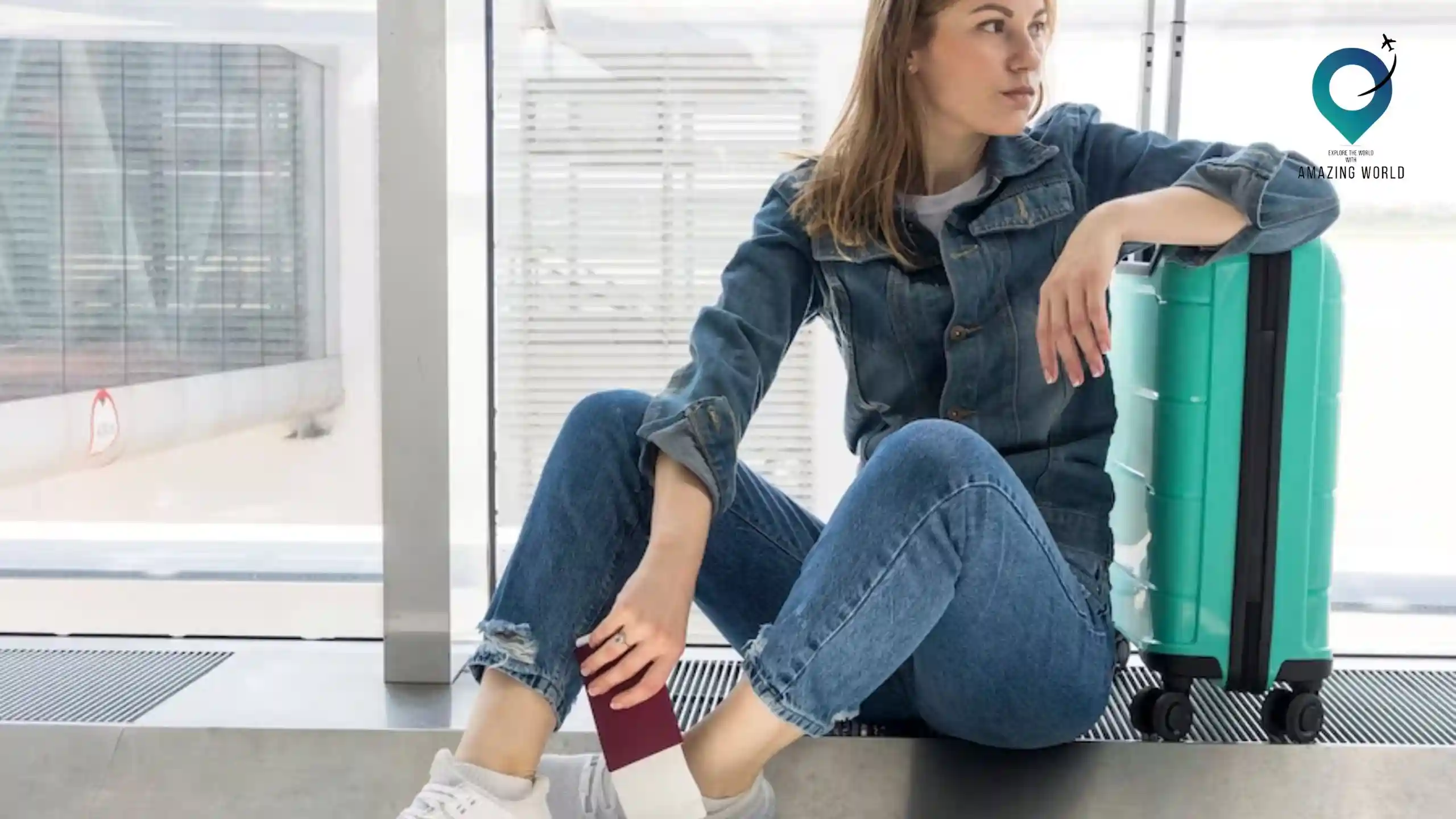How to Stay Comfortable on Long Flights: 20 Essential Tips

Are you ready to embark on a journey that’s as comfortable as it is exciting? Long flights can be daunting, but fear not! We’ve got you covered with a plethora of essential tips to keep you at ease and fully engaged during those extended airborne adventures.
From staying hydrated and packing entertainment to donning cozy compression socks and mastering the art of time zone adjustment, we’ve curated the ultimate guide to ensure your comfort and satisfaction in the skies.
So, fasten your seatbelt and get ready to soar with confidence! Let’s dive into the secrets of staying comfortable on long flights.
Pack the Right Essentials
Before embarking on your long flight, ensure you have all the essential items packed in your carry-on. Include items such as a travel pillow, a lightweight blanket, a reusable water bottle, lip balm, and hand sanitizer. These small comforts can make a significant difference in your in-flight experience.
Choose the Best Seat
Selecting the right seat can have a huge impact on your comfort during a long flight. If possible, opt for an aisle seat to stretch your legs more easily and have quicker access to the restroom. Additionally, consider seats near the wings, as they tend to experience less turbulence.
Wear Comfortable Clothing
When dressing for a long flight, prioritize comfort over style. Choose loose-fitting, breathable clothing that allows for easy movement. Layers are also a great option to adapt to temperature changes on the plane.
Stay Hydrated
To stay comfortable on long flights, one of the most important tips is to stay hydrated. Dehydration is a common issue during air travel due to the low humidity levels in the cabin. Here are some helpful ways to ensure you stay hydrated during your journey:
- Drink Plenty of Water: Carry a reusable water bottle with you and ask the flight attendants to refill it as needed. Drinking water throughout the flight will help keep your body hydrated and prevent discomfort.
- Avoid Excessive Caffeine and Alcohol: While it may be tempting to enjoy a cup of coffee or an alcoholic beverage during the flight, these drinks can contribute to dehydration. Instead, opt for water or herbal tea.
- Use Hydrating Skincare Products: The dry air in the airplane cabin can also affect your skin. Bring travel-sized moisturizers and hydrating facial mists to keep your skin refreshed and prevent dryness.
- Eat Water-Rich Foods: Choose water-rich snacks like fruits (e.g., watermelon, oranges) and vegetables (e.g., cucumber, celery) to supplement your water intake.
- Avoid Salty Snacks: Salty foods can make you feel thirstier and contribute to dehydration. Opt for low-sodium snacks to maintain proper hydration levels.
- Consider Electrolyte Drinks: Electrolyte drinks can be beneficial on long flights, as they help replenish essential minerals lost through sweat and can aid in maintaining hydration.
- Moisten Your Nasal Passages: The dry cabin air can also affect your nasal passages, leading to discomfort. Use a saline nasal spray to keep them moisturized.
- Limit Diuretics: Diuretics, like some medications and caffeine, can increase urine production and contribute to dehydration. If possible, avoid excessive use of diuretic substances before and during the flight.
By prioritizing hydration and adopting these practices, you can ensure a more comfortable and enjoyable long flight. Remember to drink water regularly, moisturize your skin, and avoid dehydrating substances to arrive at your destination feeling refreshed and ready to embark on your adventures.
Avoid Caffeine and Alcohol
When it comes to staying comfortable on long flights, one important tip is to avoid consuming excessive caffeine and alcohol. While these beverages might seem appealing during your journey, they can have adverse effects on your overall comfort. Here’s why it’s essential to limit your intake of caffeine and alcohol during flights:
- Dehydration: Both caffeine and alcohol are diuretics, meaning they can increase urine production. When you’re on a long flight, the cabin’s low humidity levels can already lead to dehydration. Consuming these drinks can exacerbate the problem, leaving you feeling even more uncomfortable and fatigued.
- Disrupted Sleep: Long flights often require rest, and getting quality sleep can make the journey more bearable. However, caffeine can interfere with your ability to fall asleep, making it challenging to get the rest you need. Similarly, while alcohol may initially make you drowsy, it can disrupt your sleep patterns, leading to less restorative rest.
- Jet Lag: If you’re crossing multiple time zones during your flight, the effects of jet lag can be intensified by caffeine and alcohol consumption. These substances can further disrupt your body’s natural circadian rhythm, making it more challenging to adjust to the new time zone.
- Mood Swings: Caffeine and alcohol can also affect your mood. While caffeine may lead to jitters and increased anxiety, alcohol’s depressive effects can make you feel emotionally drained and irritable during the flight.
Instead of relying on caffeine or alcohol, consider these alternatives to stay comfortable and relaxed:
- Water: Drink plenty of water throughout the flight to stay hydrated and combat the dry air in the cabin.
- Herbal Tea: Opt for caffeine-free herbal teas for a soothing and calming beverage option.
- Mocktails: If you enjoy the taste of alcoholic drinks, consider asking for non-alcoholic mocktails during the flight.
- Natural Sleep Aids: If you struggle to sleep on flights, explore natural sleep aids like chamomile tea or melatonin supplements (consult a healthcare professional before using any supplements).
By avoiding excessive caffeine and alcohol and choosing healthier alternatives, you can enhance your comfort and well-being during long flights. Remember, proper hydration and rest are essential for making the journey as pleasant as possible.
Move and Stretch Regularly
Moving and stretching regularly is crucial for staying comfortable on long flights. When you’re confined to a small space for an extended period, your body can become stiff and tense, leading to discomfort and even pain.
Taking short breaks to move around and stretch helps improve blood circulation and prevents muscles from becoming overly stiff. Simple exercises like ankle circles, shoulder rolls, and neck stretches can alleviate tension and reduce the risk of cramps.
Additionally, walking up and down the aisle or doing light stretches near your seat can also provide relief. Regular movement not only keeps your body more comfortable but also helps combat the feeling of restlessness that often accompanies long flights.
Incorporating these easy exercises into your journey ensures that you arrive at your destination feeling more relaxed and ready to enjoy your travel experience.
Use a Neck Pillow
A neck pillow provides crucial support for your neck and head, especially during extended periods of sitting. It helps maintain a more natural alignment of your spine, preventing neck strain and discomfort. With a neck pillow, you can relax and even catch some restful sleep during the flight, ensuring you arrive at your destination feeling refreshed.
Bring Noise-Canceling Headphones
Noise-canceling headphones are a game-changer when it comes to blocking out the ambient noise in the airplane cabin. They use advanced technology to counteract external sounds, creating a peaceful and quiet environment for you to relax or enjoy entertainment without disturbances.
Whether you prefer listening to soothing music, watching a movie, or simply having a moment of tranquility, noise-canceling headphones will make your journey much more enjoyable.
Pack an Eye Mask and Earplugs
For those who have trouble sleeping in bright or noisy environments, an eye mask and earplugs are essential travel companions. The eye mask blocks out any unwanted light, helping you create a cozy and comfortable sleeping environment.
Coupled with the earplugs, which dampen external noises, you can immerse yourself in a peaceful cocoon and promote better rest during the flight.
Entertainment: Books, Movies, and Music
On long flights, it’s essential to have a source of entertainment to keep yourself engaged and pass the time more pleasantly. Packing entertainment options like books, movies, and music can be a game-changer during the journey.
Books: Bringing a captivating book or e-reader loaded with your favorite titles allows you to escape into different worlds and immerse yourself in exciting stories. Whether you prefer fiction, non-fiction, or a mix of genres, a good book can make the flight fly by (pun intended).
Movies: Most airlines offer in-flight entertainment systems, but it’s always a good idea to have a backup plan. Load your laptop or tablet with movies or TV shows you’ve been wanting to watch. Not only will this provide you with entertainment, but it can also help you relax and unwind during the flight.
Music: Music is a powerful mood enhancer and can help create a relaxing atmosphere. Prepare a playlist with your favorite songs, soothing tunes, or even some upbeat tracks to keep your spirits high. Music can be particularly helpful if you’re looking to nap or block out background noise.
Keep Your Skin Moisturized
As important as entertainment is, don’t forget to take care of yourself during the flight, and one crucial aspect of self-care is keeping your skin moisturized.
The dry air in the airplane cabin can cause your skin to become dry and uncomfortable. To combat this, make sure to bring a travel-sized moisturizer with you. Apply it regularly, especially on exposed areas like your face and hands, to keep your skin hydrated and prevent it from feeling tight or itchy. A moisturizer with added antioxidants can also help protect your skin from environmental stressors during the flight.
Additionally, consider using a hydrating facial mist to refresh your skin throughout the journey. These mists can provide a quick burst of hydration and give your skin a rejuvenating boost. Keeping your skin moisturized not only enhances your comfort but also ensures you arrive at your destination with a healthy and glowing complexion.
Utilize Compression Socks
Wearing compression socks during long flights can significantly improve your comfort and reduce the risk of certain health issues. The cabin pressure and prolonged sitting can lead to poor blood circulation, causing swelling in the feet and legs.
Compression socks work by applying gentle pressure to your legs, helping to enhance blood flow and prevent swelling. They can also reduce the likelihood of developing deep vein thrombosis (DVT), a serious condition where blood clots form in the deep veins, which can be a risk during long periods of immobility. Investing in a pair of compression socks can make a notable difference in your overall well-being during the flight.
Opt for Loose Shoes
Choosing the right footwear is essential for maintaining comfort during a long flight. Opt for loose-fitting shoes that provide ample space for your feet to breathe and move. Feet can naturally swell during extended sitting, so tight-fitting shoes can lead to discomfort and even pain.
Slip-on shoes or shoes with adjustable closures are convenient options for easily accommodating any swelling that may occur.
Additionally, avoid wearing high heels or shoes with rigid soles, as they can restrict blood flow and lead to discomfort. Prioritize comfort over style when it comes to footwear for long flights.
Mind Your Posture
Maintaining good posture is crucial for preventing back pain and discomfort during flights. When sitting for an extended period, it’s easy to slouch or adopt an improper posture, which can strain your back and neck.
To promote better posture, sit with your back against the seat and use a small pillow or lumbar support cushion if needed. Keep your feet flat on the floor or on a footrest if provided, and avoid crossing your legs for extended periods.
Taking short breaks to stand up and stretch can also help reset your posture and prevent stiffness. Being mindful of your posture throughout the flight can contribute to a more comfortable journey and reduce the risk of post-flight aches and pains.
Practice Breathing Exercises
During long flights, practicing breathing exercises can be a valuable tool for promoting relaxation and reducing stress. Deep breathing techniques can help calm the nervous system and reduce anxiety, making the flight more comfortable. One simple and effective method is diaphragmatic breathing, where you inhale deeply through your nose, allowing your diaphragm to expand fully, and then exhale slowly through your mouth. Focus on the rhythm of your breath and try to make your exhales longer than your inhales. Incorporating these breathing exercises throughout the flight can help you stay calm, centered, and at ease.
Snack Wisely
Choosing the right snacks can make a difference in how you feel during the flight. Opt for light and healthy snacks that provide sustained energy without making you feel too full or sluggish. Some excellent snack options include fresh fruits, nuts, granola bars, and cut-up vegetables. Avoid sugary or greasy snacks, as they can cause energy spikes and crashes, leading to discomfort. Additionally, bringing your own snacks can be beneficial, as it ensures you have options that suit your preferences and dietary needs.
Avoid Heavy Meals
Before the flight, refrain from consuming heavy or large meals that could leave you feeling bloated or uncomfortable during the journey. Heavy meals can take longer to digest, and the limited movement on the plane may worsen the feeling of fullness. Instead, opt for a balanced and moderate meal before the flight that includes lean proteins, whole grains, and vegetables.
Stay Clean and Fresh
Maintaining personal hygiene throughout the flight is essential for feeling comfortable and refreshed. The confined space of an airplane can easily make you feel less than fresh, but there are simple steps you can take to stay clean during the journey.
- Face Wipes or Cleansing Towelettes: Keep a pack of face wipes or cleansing towelettes in your carry-on. These handy items can quickly freshen up your face and remove any excess oil or dirt, leaving your skin feeling revitalized.
- Toothbrush and Toothpaste: Brushing your teeth mid-flight can work wonders in helping you feel clean and more awake. Don’t forget to pack a travel-sized toothbrush and toothpaste to maintain oral hygiene.
- Deodorant: Applying deodorant before and during the flight will help you stay odor-free and confident, especially during long journeys.
- Hand Sanitizer: Airports and airplanes can be breeding grounds for germs. Carry a travel-sized hand sanitizer to clean your hands before eating or touching your face.
- Fresh Clothing: Consider packing a fresh set of clothes, such as a clean shirt or a pair of socks, in your carry-on. Changing into fresh clothes midway through the flight can provide a sense of renewal and cleanliness.
Stay Positive and Relaxed
Maintaining a positive and relaxed mindset is crucial for a comfortable flight experience. Long flights can be challenging, but focusing on the positive aspects of your journey can make it more enjoyable.
- Practice Mindfulness: Engage in mindfulness exercises to stay present and reduce feelings of restlessness. Pay attention to your breath, surroundings, and sensations to stay grounded.
- Listen to Relaxing Music or Guided Meditations: Create a playlist of calming music or listen to guided meditations to ease anxiety and promote relaxation during the flight.
- Enjoy the View: If you have a window seat, take advantage of the unique view from above the clouds. Watching the scenery can be soothing and awe-inspiring.
- Engage in Light Conversation: If you’re traveling with a companion or seated next to a friendly fellow passenger, engage in light conversation to pass the time and create a pleasant atmosphere.
- Stretch and Move: Continue practicing light stretching and movement to relieve tension and promote relaxation.
- Set Realistic Expectations: Understand that long flights can be tiring, and it’s okay to feel a little worn out upon arrival. Give yourself permission to rest and recover before diving into your travel plans.
Adjust to the Local Time Zone
Adjusting to the local time zone is a crucial step to ensure a comfortable and seamless transition during your long flight and upon arrival at your destination. Traveling across multiple time zones can lead to jet lag, which can leave you feeling fatigued and disoriented. Here are some tips to help you adjust to the local time zone effectively:
- Sleep on the Plane: If your flight aligns with the nighttime of your destination, try to get some rest on the plane. Bring along a neck pillow, eye mask, and earplugs to create a comfortable sleeping environment. Setting your watch to the local time of your destination can mentally prepare you for adjusting your sleep schedule.
- Stay Hydrated: Drink plenty of water during the flight to stay hydrated, but also be mindful of your fluid intake closer to your arrival time. Reducing your water consumption a few hours before landing can minimize the need for frequent bathroom visits and help you sleep better during the flight.
- Avoid Napping Upon Arrival: It’s tempting to take a long nap when you finally arrive, especially if you’re feeling tired. However, try to resist the urge to nap for too long, as it can disrupt your sleep schedule. Instead, engage in light activities and get some exposure to natural sunlight, which can help reset your internal clock.
- Adapt Meal Times: Once you arrive at your destination, adjust your meal times to align with the local schedule. Eating meals at regular intervals according to the local time can help your body adjust more quickly to the new time zone.
- Stay Active: Engage in light physical activity or take a walk outside to combat drowsiness and encourage your body to adapt to the local time. Exposure to natural light can also help regulate your circadian rhythm.
- Avoid Stimulants: Minimize the consumption of caffeinated beverages and other stimulants, especially in the late afternoon and evening, as they can interfere with your ability to fall asleep at the appropriate time.
- Be Patient: Adjusting to a new time zone takes time and patience. Be kind to yourself and allow your body a few days to adapt fully. Focus on getting good quality sleep and maintaining a consistent daily routine to help your body establish its new sleep-wake cycle.
By consciously making an effort to adjust your sleep and activity patterns to the local time zone, you can minimize the effects of jet lag and ensure a smoother and more comfortable transition to your new location. With these tips, you’ll be better prepared to make the most of your travels and fully enjoy your experiences at your destination.
Conclusion
staying comfortable on long flights is entirely possible with the right strategies and preparations. By incorporating various tips and practices, you can make your journey more enjoyable, ensuring you arrive at your destination feeling refreshed and ready for your adventures.
Prioritize hydration by drinking plenty of water, while avoiding excessive caffeine and alcohol, as they can lead to dehydration and disrupt your rest. Utilize a neck pillow, noise-canceling headphones, and an eye mask with earplugs to enhance comfort and promote relaxation during the flight.
Remember to move and stretch regularly to improve blood circulation and prevent stiffness. Pack entertainment options such as books, movies, and music to keep yourself engaged and occupied throughout the journey. Keep your skin moisturized to combat the effects of dry cabin air and arrive with a healthy glow.
How much did you like Our detailed How to Stay Comfortable on Long Flights: 20 Essential Tips? Review Also, please share these Blogs with your friends on social media.
Related Article –
- Road Trips Ideas | 12 Tips to Prepare Your Car for a Long Road Trip?
- 150 Best Places to Visit in the United States In 2023
- Road Trip With Kids
- How to Stay Awake While Driving Long Distances
- Audiobooks to Listen to On Your Road Trip
- How to Create an Epic Itinerary Road Trip
- Best Rental Cars For Travel Adventures
Comfortable on Long Flights FAQs
Are compression socks necessary for short flights?
Compression socks are beneficial for any flight duration, especially if you have circulation issues.
Can I use my phone during the flight?
Yes, you can use your phone in airplane mode, but follow the airline's guidelines.
Should I take a sleeping pill to rest on the flight?
It's best to avoid sleeping pills unless prescribed by a doctor, as they can have side effects.
Is it essential to adjust my sleep schedule for a short trip?
If you'll be changing time zones significantly, it's helpful to adjust your sleep schedule accordingly.

Meet David Hoper, a passionate travel Blog writer with 7+ years of experience in travel content. Through his exemplary storytelling and engaging narratives, he shares his experiences and brings destinations to life. With a keen eye for detail and a love for exploration, he has cultivated a diverse portfolio of travel blogs that inspire and inform readers worldwide.








